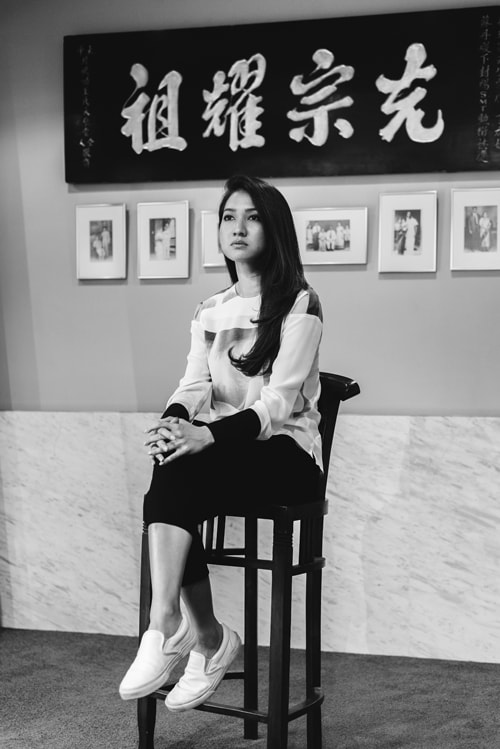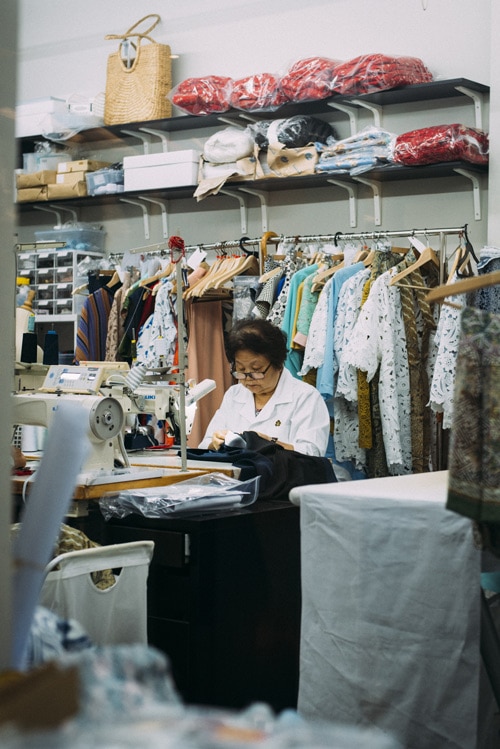Priscilla Shunmugam: Asia's Pride and Prejudice

Priscilla Shunmugam speaks with a measured cadence that lends graceful import to her words. Listening back on my interview with the 36-year-old fashion designer, I revel in the auditory wash of the low, slow and velvet tones of her voice, which is distinctly clear on record, filtering out the clatter and clamour of the bustling café we’d met in. This renegade former lawyer clearly appreciates the power of eloquent, well-timed oratory. Parsing words with weighted silences and an ever-so-slightly theatrical drawing out of single syllables into two or more notes, her sentences are imbued with poetic nuance. The ruminative pace of Priscilla’s speech should not come as a surprise from someone known for her daring, yet deliberate grappling of large and delicate subjects in the postmodern Asian vernacular. Race, culture, heritage and identity are topics intrinsic to her deeply personal label, Ong Shunmugam, named in tribute to her Chinese and Indian parentage. During the course of our hour-long conversation, Priscilla is forthcoming and candid in discussing her motivations, South East Asian culture and identity in the modern world, as well as the state of Singapore’s fashion industry. If her understated thoughtfulness feels like a rarity in a field where flamboyant individuality, flash and wit—sartorial and otherwise—are by equal parts lauded and flaunted, then perhaps it is because Priscilla has been careful to draw the line between what she calls, “the ‘me’ at work”, and “the ‘me’ outside of it”. “I remember when I was first starting out, fashion editors told me to understand that as a designer and a creative person, people will want access to my thoughts, especially when the work that I do and the way it is done, is remarkably different than the norm. That has helped me to understand where the questions come from, and I’m quite at ease with exposing the parts of me that have struggled privately, for a long time, with the issues and topics that my collections raise. Beyond that, however, I remain guarded. Because, really—who would be interested and why does that matter, anyway?”
TEO REN FENG: Your work holds deep and personal meaning to you.
PRISCILLA SHUNMUGAM: Yes. RGB 2017 and previous collections all came from long-time questions that I’ve had and struggled with. There’s definitely a part of me and an act of exposure or transparency with every collection, which I cannot run away from and have come to terms with.
REN FENG: What are the core values of Ong Shunmugam?
PRISCILLA: We’re keeping true to what we’ve always tried to do: talking about things that people don’t want to talk about, and making them think more and challenge our comfort zones. It started out as a very personal statement, but I feel it has developed way beyond that now. The brand has come to mean different things to different people—many have told me Ong Shunmugam is like a movement. It has caught the hearts and minds of like-minded people whom I have never met, heard of, or come into contact with. I’m quite happy it’s turned out that way, because I am not the brand and the brand is not me.
REN FENG: Do you feel you deserve the success and attention that you have received thus far?
PRISCILLA: I’m still at odds with it, especially with the attention. I know my job and I do it well… but at the same time, I’m never going to have an Instagram account to collect followers, post selfies or whatever. That’s never going to be me.
REN FENG: Do you consider yourself a private person?
PRISCILLA: Yes. I have, or I had a personal Instagram account which I set to ‘private’—and I thought I was doing the right thing. But I started getting requests and people got upset when I didn’t accept their follow requests.
"I’m not content with being average."
REN FENG: What is one experience you’ve had that you don’t believe anyone else has ever experienced?
PRISCILLA: Oh, plenty… where do I begin? [laughs] I know I’ve become a bit of a ‘signpost’ for those looking to change their lives or break out of something that they feel stuck in to pursue what they’ve always wanted to do. It’s fine and I get it—not many people have experienced the amount of change that I’ve had. Not just a change in industry, job or career, but just finding a completely new direction in life—repurposing your body, mind, and skill set to serve another purpose and mission. It’s an experience I wouldn’t wish on many, because it is not easy to weather massive change, and to be really hard on yourself to not give up or accept anything less. I’m not content with being average.
REN FENG: Can you define yourself in three words?
PRISCILLA: Restless. That has been the case since forever. Curious and… empathetic.
REN FENG: On the subject of being restless, do you ever think of working on something else now, besides your own label?
PRISCILLA: I am a multitasker and pretty open-minded, but somehow the brand and the business have kept me occupied with a really nice spectrum of things to do. In the 7 years since I’ve started it, I’ve not had the feeling that the grass is greener elsewhere, which is very telling for someone who’s always been mentally restless, and who’s never wanted to miss out on something else better. I want to cherish this feeling because it’s not easy to come by.
REN FENG: Who is the ideal Ong Shunmugam girl?
PRISCILLA: I don’t have one and that’s the honest answer. But we have many inspiring customers—really remarkable, extraordinary women—who are inspiring because they don’t crave fame, limelight or attention. It’s only because of the shop that I’ve gotten to know of their existence and they remind me of the women in my family: my mother, my grandmothers and my aunts—women who have never felt the need to shout about their achievements from the rooftops, but are just completely reliable and consistent in what they do, and also very selfless with no motives. More and more, I’m realising the value of these qualities.
REN FENG: Ong Shunmugam’s pieces aren’t quite everyday casual wear. What is the brand’s relationship with the modern Asian women that it dresses?
PRISCILLA: Occasion wear can speak volumes. It’s a category where our customers are either celebrating or commemorating something significant like a wedding, birthday, or a milestone like an important presentation or speech. I think it tells a lot when people want to go through these key moments in their lives with Ong Shunmugam. You don’t think too much when you are dressing casually, but when it comes to a moment in your life that you want to remember and mark, that’s when you really start to think about what you’re wearing. It’s no longer just clothing but a completion of the ceremony for our customers. Such a mental and emotional exchange is a very powerful relationship to have.
"We are pushing to take traditional wear out of the costume category."
REN FENG: I see Ong Shunmugam as an effort to bring Asian cultural wear to “life”—an attempt to make it more relevant, relatable and wearable.
PRISCILLA: Yes, that’s definitely our mantra and a must-do. We are pushing to take traditional wear out of the costume category, allowing it to roam free within the contemporary fashion vocabulary and compete head-on with other categories of dress.
REN FENG: In taking on subjects such as Asian culture, tradition and authenticity in your work, can Ong Shunmugam be viewed as an attempt to “awaken” Asian fashion from the stupor of a “colonial hangover”?
PRISCILLA: Yes, I guess you could put it that way. Questions like these have been asked before in academia, so it’s nothing new. But in the context of fashion, the very accessible and popular industries like retail and consumer goods don’t have that kind of conversation, on such a scale. What we needed was someone, or a collective of people to come together to put things out there, and clearly articulate thoughts, concerns and questions in a way that hasn’t been done before. Maybe what’s key here is taking really nerdy, niche questions and putting them out there—forcing people to listen. It’s okay if they don’t have the answer, we just want to get them thinking about the issues.
REN FENG: Do you need a full understanding of an item’s history and background to avoid cultural misappropriation?
PRISCILLA: Yes, I think so.
REN FENG: Is it the responsibility of the average individual to be educated on it?
PRISCILLA: When it comes to creation or design, I never want to be too pedantic or patronising, and say things like: This is how you should do it. This is the right way. I can completely appreciate when things are done with nostalgia, kitsch or in direct imitation, because you just want to replicate it. It’s still a form of creation, and we can all appreciate very easy translations like that. But at the same time, we should have representation from all ends of the spectrum, space for more thoughtful and accurate translations, as well as those that are a bit more abstract and progressive…
REN FENG: How does your recent foray into Malay womenswear, Gadis Perkasa, engage with the current zeitgeist in the Malay/Muslim community?
PRISCILLA: Well, the collection wasn’t meant for Malay women or Muslim women in particular. It’s just a collection of Malay womenswear and the idea was to put Malay wear out there for every woman to appreciate and call her own. We know that the cheongsam is a traditional Chinese clothing, but it doesn’t mean that it’s only meant to be worn by ethnically Chinese women—women of any race are open and welcome to wear it. I knew, even as a child, that traditional Malay womenswear doesn’t enjoy that level of accessibility. It’s not looked at the same way, which is something we need to change.
REN FENG: You’ve alluded to “misinterpretations, misconceptions [and] misappropriations” that entangle our perceptions of Malay traditional wear. Can you elaborate on this?
PRISCILLA: Back when I was schooling in Malaysia, wearing a baju kurung was one of our uniform options. As a group of friends, we used to decide a day before, when we would all wear our baju kurung to school together. One of my friends, who was Chinese, would always come to school the next morning with a really sour face. We eventually found out it was because her grandmother would tell her off every time she wore the baju kurung, simply because she felt that wearing it meant that my friend wished to be Malay. That statement from a grandmother to a granddaughter, tells you everything you need to know about the Malaysia and Singapore that we’ve been born into. I don’t want to just… hang out on the surface and pretend all is right.
REN FENG: How does your collection seek to address this divide?
PRISCILLA: Gadis Perkasa is our way of turning to Malay women and letting them know that we’re thinking of them too, especially since mainstream fashion typically doesn’t pay much attention to ethnic diversity. Education also goes hand-in-hand with what we’re doing, since we’re also speaking to non-Malay women and saying: Hey, have you heard of the baju kurung? You can wear this too. It’s not going to do anything bad to you, and it’s beautiful and flattering. If you really want to express your South East Asian identity, it doesn’t get more accurate and authentic than with these forms of dress. It’s genuinely ‘born’ in South East Asia, unlike the cheongsam and sari, which are direct imports from the motherlands. I’m just trying to make a case for a different identity and for expressing yourself through dress.
REN FENG: In the course of your work, how do you know when to compromise or when to resist?
PRISCILLA: I’m definitely better at letting go. I think that came hand-in-hand with building a team—a reliable, trustworthy and freakishly-talented team who’ve given me the confidence to open up and allow them to… I guess, cover my blind spots. It hasn’t been an easy transition, but I’m very happy that I am now at the stage where we can be very open and supportive of each other. It’s a great feeling for anybody who has had to juggle and work solo, which was essentially me, in the first 3 years of the label.
REN FENG: You’ve mentioned having to “toe the line” and doing “what was expected” of you as a brand, previously. What did you mean by that?
PRISCILLA: When you are a new brand in the market, there are going to be things that you feel you need to do—which you think you can’t say no to—because you’re fitting into the system. You end up always saying yes, until it reaches a stage where you have to look hard at your business, brand, team and even customers, and remind yourself of what’s truly important. It has not been an easy decision to make, but it definitely feels like a step in the right direction.
"This is the first time I feel I have a team of people beside me, not behind me, and the feeling is amazing."
REN FENG: How are you evolving then?
PRISCILLA: Launching Gadis Perkasa was a very important milestone for us. It has been heartwarming to make that statement and receive great industry, media and commercial support. 2017 has been introspective. It’s about going deep into ourselves—back into our caves—to reemerge, refreshed. We’re keeping collaborations to a minimum and working on internationalising the brand and launching our accessory line. This is the first time I feel I have a team of people beside me, not behind me, and the feeling is amazing.
REN FENG: Which countries are you planning to go into?
PRISCILLA: London and Paris, that I’m pretty sure of—and negotiating elsewhere.
REN FENG: What can we look forward to seeing from Ong Shunmugam at this year’s Singapore Fashion Week?
PRISCILLA: I don’t know if we will be taking part. [laughs] We’re exploring different ways to present our work, something I’ve been keen on for a few years now. Even on a global level, many brands have started relooking at their strategies in terms of presentation and I definitely see the benefits of manifesting your work in different ways. We’re currently in talks to try and see how we can bring our show to life in a way that is a bit more authentic to who we are.
REN FENG: Is there anyone in the fashion world whose business or career you wish to emulate?
PRISCILLA: We definitely study a couple of labels and look up to them, but every time you get emotional about it, you quickly realise that parallels can’t be drawn because they are living with a very different industry, a different world and environment to what we are in. So I try not to engage in that exercise because it leads me nowhere.
REN FENG: How do you envision the future of Singapore fashion?
PRISCILLA: The current state of the fashion industry is not necessarily going to change or get better unless we—and when I say “we”, what I really mean are the people with decision-making powers—decide that there are things to be changed. Right now, it seems like a systemic problem, not something that any individual or small collective can change. We’re still going to have 5 fashion design schools producing graduates every year, when we have no jobs to give them, or fashion labels to hire them.
REN FENG: Singapore doesn’t have a native fashion industry to support designers and fashion school graduates. We don’t even have a textile industry. Do you see these issues as surmountable?
PRISCILLA: That’s what I mean; we shouldn’t be having 5 fashion design schools in the first place. It’s just symptomatic of the problem that we have. We assume that by producing fashion design graduates, we’re going to have a fashion design industry. And we presume that by having fashion shows and competitions, that’s enough to cut it. But it’s not. Until we realise what we’re lacking, and decide how serious we are about changing it, that’s when things will improve. Back in the 1980s, when certain decisions were made to take Singapore away from being a manufacturing economy, the priority shifted from manufacturing to a knowledge economy. That meant over time, certain industries would see a natural death, like garment manufacturing. Almost thirty years later, fashion designers like myself are paying the price. We’re struggling to make sense of an economy that actually has no place for us.
****
Edited by Wy-Lene Yap





